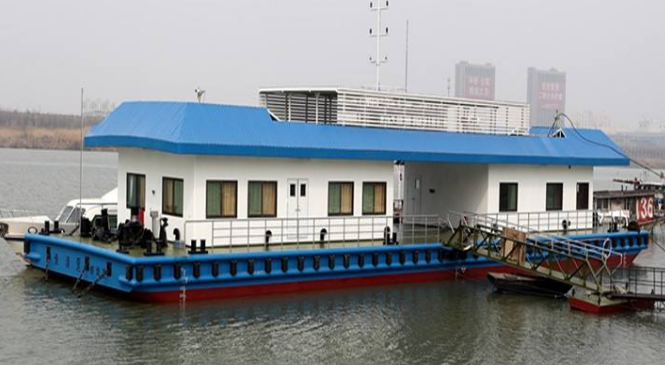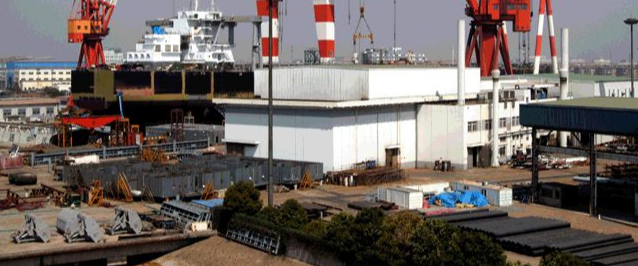Research on Marine carrier equipment technology and industrial development
The global ship assembly manufacturing market presents a three-way pattern of China, South Korea and Japan. Since the global financial crisis in 2008, China and South Korea have been engaged in fierce competition for the main market share of global ship final assembly manufacturing. Japan has adopted a cautious industrial development strategy, and its global ship final assembly manufacturing market share has increased compared with China and South Korea. In terms of final assembly and construction technology, Japan and South Korea represent the current world advanced level, using the design-evaluation - manufacturing integrated information system, and gradually improve the level of process intelligence; The average production efficiency of ship assembly and construction in Japan and South Korea is more than 2 times higher than that of Chinese shipyards.

4. Information and communication navigation
The main competition pattern of the world's ship communication and navigation equipment is composed of Europe, the United States and Japan, and the mainstream ocean transport ships are mostly equipped with European and American integrated systems. These ship communication navigation equipment manufacturers have a perfect global service network, monopolizing the global communication navigation product market. At the same time, foreign enterprises attach importance to the integration, standardization and intelligence of data resources of information and communication navigation equipment and its upstream and downstream products.
5. Power and supporting electromechanical field
The world high-end diesel engine market is almost monopolized by developed countries. According to brand share statistics in Clarkson database, German Man Group has more than 80% of the global low-speed diesel engine market share; Wartsila of Finland, Caterpillar of the United States, Hyundai Group of South Korea, Daihatsu Industrial Co., Ltd. of Japan, and Yanma Co., Ltd. of Japan account for more than 90% of the global market share of medium-speed diesel engines. In the field of Marine nuclear power, the United States and Russia are typical representatives, with advanced research and development systems and industrial systems, forming a complete lineage of Marine nuclear power equipment. In terms of Marine special propulsion equipment, foreign countries have also formed high-power, standardized and serialized products to meet the market needs of various types of ships. At the same time, foreign enterprises also occupy a dominant position in the field of ship auxiliary machinery such as deck machinery and cabin machinery.
(2) Advanced cutting-edge technologies for the world's Marine transport equipment
1. Current advanced technology
(1) The application of LNG fuel technology in ocean-going ships
For some time to come, the main alternative fuel for ships is LNG. Natural gas reserves are large, and with the continuous construction of infrastructure, natural gas is becoming more and more available. At present, among the existing LNG fuel ships, ferries and offshore ships account for the majority, and the proportion of container ships, oil tankers and chemical tankers is catching up, such as the international development and design of 20,000 TEU LNG powered container ships has made great progress.
(2) Solar and wind energy technologies for large ships
The shipping industry is exploring the application of renewable energy to power the fleet, and the relevant technologies have entered the trial and testing phase. For example, Dalian Shipbuilding Industry Group Co., Ltd. built the world's first 3.08× 105 DWT ultra-large crude oil vessel equipped with sail equipment for China Merchants Energy Transportation Co., LTD., which has been delivered and put into operation and completed several voyage tasks. The most potential application direction in the future is to reduce fuel consumption as a supplement to existing energy sources.

(3) Polar ship technology
With the increasing strategic position of the Arctic region, maritime transport in the Arctic region has attracted widespread attention, and the reduction of ice caused by global warming has also made Arctic navigation more feasible. In addition, the growing tourism and fishing industries in the polar regions have created new demands for polar ships. Polar ship hull structure design, monitoring system, emergency response system, equipment reliability under changing environment are the focus of subsequent research and development.
(4) Ship noise control technology
Ship noise may affect the health of Marine life, crew and passengers. The Ship Noise Levels Code issued by the International Maritime Organization provides a reference standard for the prevention of potentially dangerous noise levels on board ships, and provides a reference standard for an acceptable environment for crew members. In addition, the International Organization for Standardization is promoting the development of international standards for ship noise. At present, the research on ship noise generation mechanism, forecasting method and control method is still a hot spot.
- EMERSON
- Honeywell
- CTI
- Rolls-Royce
- General Electric
- Woodward
- Yaskawa
- xYCOM
- Motorola
- Siemens
- Rockwell
- ABB
- B&R
- HIMA
- Construction site
- electricity
- Automobile market
- PLC
- DCS
- Motor drivers
- VSD
- Implications
- cement
- CO2
- CEM
- methane
- Artificial intelligence
- Titanic
- Solar energy
- Hydrogen fuel cell
- Hydrogen and fuel cells
- Hydrogen and oxygen fuel cells
- tyre
- Chemical fiber
- dynamo
- corpuscle
- Pulp and paper
- printing
- fossil
- FANUC
- Food and beverage
- Life science
- Sewage treatment
- Personal care
- electricity
- boats
- infrastructure
- Automobile industry
- metallurgy
- Nuclear power generation
- Geothermal power generation
- Water and wastewater
- Infrastructure construction
- Mine hazard
- steel
- papermaking
- Natural gas industry
- Infrastructure construction
- Power and energy
- Rubber and plastic
- Renewable energy
- pharmacy
- mining
- Plastic industry
- Schneider
- Kongsberg
- NI
- Wind energy
- International petroleum
- International new energy network
- gas
- WATLOW
- ProSoft
- SEW
- wind
- ADVANCED
- Reliance
- YOKOGAWA
- TRICONEX
- FOXBORO
- METSO
- MAN
- Advantest
- ADVANCED
- ALSTOM
- Control Wave
- AB
- AMAT
- STUDER
- KONGSBERG
- MOTOROLA
- DANAHER MOTION
- Bently
- Galil
- EATON
- MOLEX
- Triconex
- DEIF
- B&W
- ZYGO
- Aerotech
- DANFOSS
- KOLLMORGEN
- Beijer
- Endress+Hauser
- MOOG
- KB
- Moxa
- Rexroth


Email:wang@kongjiangauto.com

















































































































